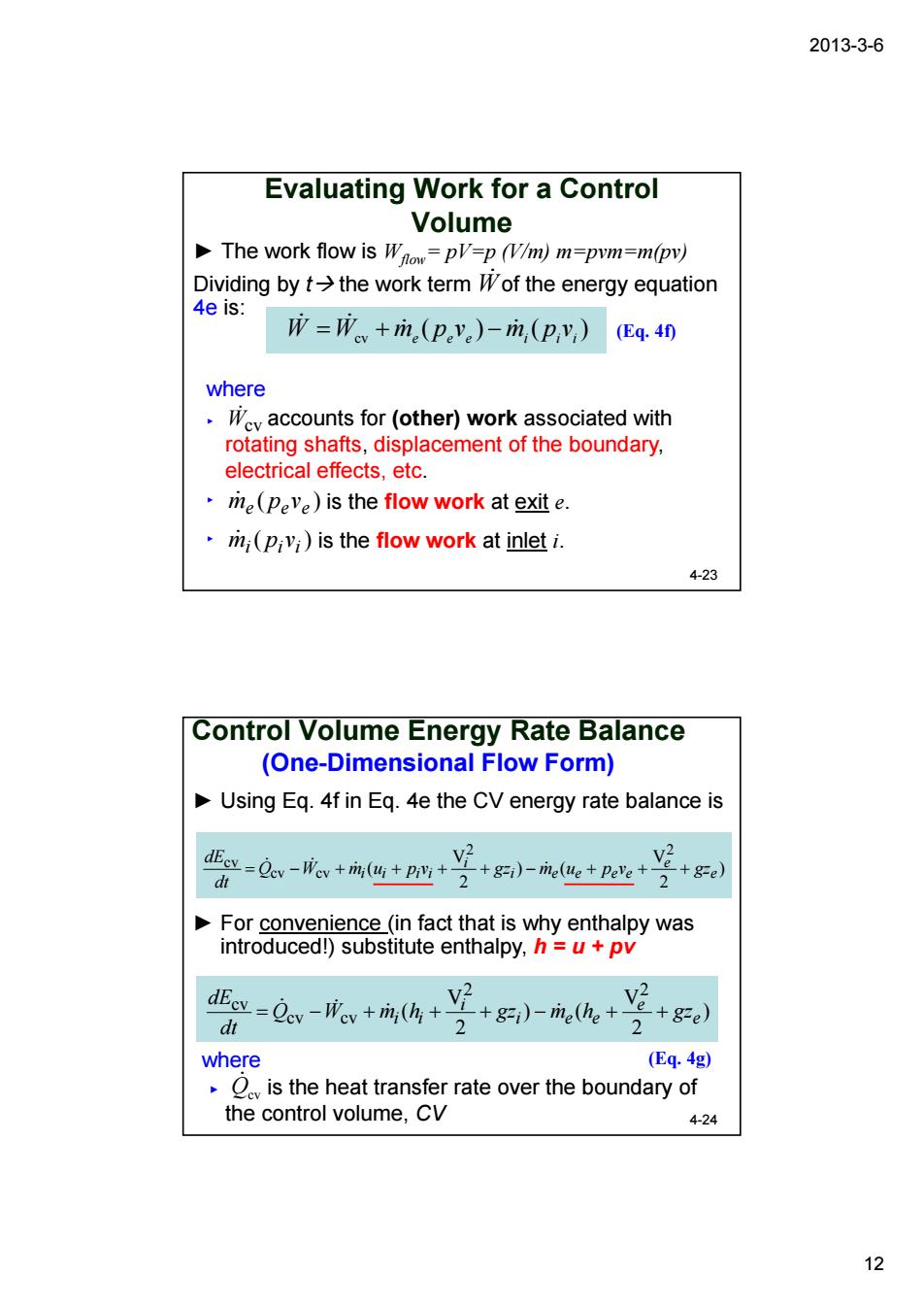
2013-3-6 Evaluating Work for a Control Volume For a CV.work is split in two parts: (1)work done by the fluid at the inlet and outlet and (2)other work. (1*)Flow work:The work required to push the mass into or out of the control volume This work is necessary for maintaining a continuous flow through a control Work Force x Distance Wnlow FL PAL PV (kJ) The flow work per unit mass is (kJ/kg) Total Energy of a Flowing Fluid Total energy of smplemsystem is e=u+ke pe =u+ +gz (kJ/kg) ◆Nith h=u+Py→total energy of flowing fluid is 0=h ke pe=h+ -+gz (kJ/kg) ( 0=D The total energy consists of three parts for a nonflowing fluid and four arts for a flowing fluid. 11
2013-3-6 11 Force applied on a fluid by piston = force applied on the piston by fluid Evaluating Work for a Control Volume ►For a CV, work is split in two parts: (1*) work done by the fluid at the inlet and outlet and (2) other work. ►(1*) Flow work: The work required to push the mass into or out of the control volume. This work is necessary for maintaining a continuous flow through a control volume. Work = Force × Distance ►The flow work per unit mass is The fluid upstream acts as a piston to push a unit of mass into or out of the control volume The total energy consists of three parts for a nonflowing fluid and four parts for a flowing fluid. ►With h = u + Pv Æ total energy of flowing fluid is Total Energy of a Flowing Fluid ►Total energy of simple compressible system is 4-22

2013-3-6 Evaluating Work for a Control Volume The work flow is Wpo=pV=p (V/m)m=pvm=m(pv) Dividing by tthe work term of the energy equation 4e Is: 市=市+m.(P.y)-m,(P,y)E440 where .Waccounts for (other)work associated with rotating shafts,displacement of the boundary, electrical effects,etc. rite(peve)is the flow work at exit e. (piv;)is the flow work at inlet i. 4-23 Control Volume Energy Rate Balance (One-Dimensional Flow Form) Using Eq.4f in Eq.4e the CV energy rate balance is v2 For convenience(in fact that is why enthalpy was introduced!)substitute enthalpy,h=u+pv =Qv-晚v+mh+ +8)m+坚 where (E4.4g) O is the heat transfer rate over the boundary of the control volume,CV 4-24 12
2013-3-6 12 Dividing by tÆ the work term of the energy equation 4e is: Evaluating Work for a Control Volume 4-23 ( ) ( ) cv e e e i i i W W m& p v m& p v & = & + − W& (Eq. 4f) Wcv & accounts for (other) work associated with rotating shafts, displacement of the boundary, electrical effects, etc. where ► ( ) e e e m& p v is the flow work at exit e. ► ( ) i i i m& p v is the flow work at inlet i. ► ► The work flow is Wflow= pV=p (V/m) m=pvm=m(pv) ) 2 V ) ( 2 V ( 2 2 cv cv cv e e i e e e e i Q W mi ui pivi gz m u p v gz dt dE = & − & + & + + + − & + + + Control Volume Energy Rate Balance (One-Dimensional Flow Form) 4-24 ► For convenience (in fact that is why enthalpy was introduced!) substitute enthalpy, h = u + pv ) 2 V ) ( 2 V ( 2 2 cv cv cv e e i e e i Q W mi hi gz m h gz dt dE = & − & + & + + − & + + (Eq. 4g) ► Using Eq. 4f in Eq. 4e the CV energy rate balance is is the heat transfer rate over the boundary of the control volume, CV where ► Qcv &

2013-3-6 Control Volume Energy Rate Balance (One-Dimensional Flow Form) In practice there may be several locations on the boundary through which mass enters or exits. Multiple inlets and exits are accounted for by introducing summations: =么v-成w+3m4+ d 之+)-m以+坚 e (E4.4h) The above equation is the accounting balance for the energy of the control volume. 4-25 oReview:Energy Balance for a Control Volume 13
2013-3-6 13 Control Volume Energy Rate Balance (One-Dimensional Flow Form) = − + ∑ + + − ∑ + + e e e e e i i i i i Q W m h gz m h gz dt dE ) 2 V ) ( 2 V ( 2 2 cv cv cv & & & & The above equation is the accounting balance for the energy of the control volume. ► In practice there may be several locations on the boundary through which mass enters or exits. Multiple inlets and exits are accounted for by introducing summations: 4-25 (Eq. 4h) Review: Energy Balance for a Control Volume http://bcs.wiley.com/he-bcs/Books?action=index&itemId=0470918012&bcsId=6606